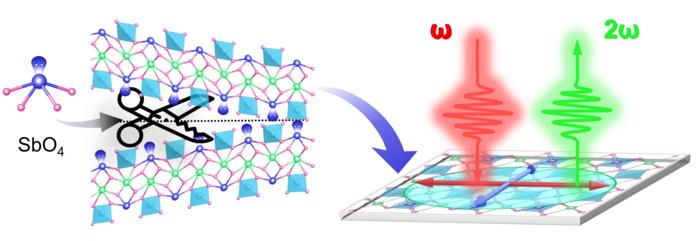
In a groundbreaking study conducted by a team from the Fujian Institute of Research on the Structure of Matter, Chinese Academy of Sciences, a unique approach to developing two-dimensional van der Waals oxides has emerged, leveraging the intriguing properties of lone pair electrons in a novel strategy dubbed “chemical scissors.” This innovative concept signifies a remarkable shift in materials science, as it not only offers insights into the structures of two-dimensional materials but also opens up entirely new avenues for potential applications in advanced photonics.
The focus of this research is on the creation of a stable two-dimensional van der Waals oxide, known scientifically as InSbMoO₆, or ISM. This material is particularly exciting due to its inherent non-centrosymmetric characteristics, which are crucial for applications requiring nonlinear optical responses. As researchers delved deeper into the properties of ISM, they discovered that it significantly exhibits in-plane anisotropy, a phenomenon that allows the material to exhibit direction-dependent behavior. This anisotropic property is essential for future developments in nanoscale optoelectronic devices.
Through meticulous experimentation, the research team successfully isolated single-layer samples of ISM using mechanical peeling techniques. This method, often employed in the field of materials science for thin films, allowed them to maintain the integrity of the newly created two-dimensional structures. The resulting ISM sheets stood out due to their robust Raman and second harmonic generation (SHG) responses, which were found to be independent of the number of layers present. This independence marks a significant step forward, as it suggests the possibility of using ISM in integrated systems without the limitations often associated with multilayered materials.
The impressive effective second-order nonlinear susceptibility observed in ISM further supports the idea that this material could serve as a pivotal component in future photonic devices. This parameter denotes the material’s ability to respond to electric fields, an essential trait for applications in systems such as frequency converters, optical switches, and other nonlinear optical setups. The pronounced nonlinear behaviors exhibited by ISM signal its potential utility in a variety of advanced technological platforms.
Stability is another crucial factor in the practical application of new materials, especially those intended for photonic uses. The researchers confirmed that ISM possesses remarkable air stability, a characteristic that enhances its appeal for real-world applications. As technology continues to evolve rapidly, the search for versatile materials that can perform optimally under various environmental conditions becomes increasingly urgent. ISM’s conducive properties provide a promising solution in this regard.
The implications of this research extend beyond the realm of material science. As demands for next-generation photonic devices and integrated circuits expand, the newly developed ISM holds substantial promise for future inventions. Architects of next-generation technology demand materials that can seamlessly integrate with existing systems while pushing the boundaries of performance—ISM appears poised to meet these demands with its unique properties.
Furthermore, the research not only positions ISM as a leading candidate for future innovations but also establishes a refined structural design strategy that could serve as a blueprint for future explorations of similar materials. The concept of utilizing lone pair electrons as “chemical scissors” illuminates pathways for the discovery of other two-dimensional van der Waals oxides, potentially yielding a rich library of new materials with tailored properties.
As discussion around two-dimensional materials continues to gain momentum, the work of Dr. Sangen Zhao and Dr. Junhua Luo exemplifies the exciting nexus of theoretical and experimental physics. Their expertise and innovative thinking contribute to a deeper understanding of how structure and electronic properties interplay in two-dimensional systems. The encouragement this research provides to both seasoned scientists and emerging researchers alike is invaluable, particularly in a landscape that is forever evolving.
In addition, the scientific community stands to benefit tremendously from the insights gained through the study of ISM. The exploration of novel materials not only enriches our fundamental knowledge but lays the groundwork for transformative technologies. As the fields of materials science and photonics converge, the potential applications for ISM and similar materials could redefine optoelectronics, providing unprecedented solutions to current and future challenges.
Overall, this pioneering work is a testament to the extraordinary capabilities of scientific inquiry. The team’s findings reflect the ongoing commitment to innovation within the field, showcasing the intricate connections between fundamental research and practical applications. As we peer into the future, materials like ISM could very well play a central role in shaping the next generation of high-performance electronic and photonic devices.
The impact of this research resonates well beyond the laboratory, influencing industries that rely heavily on advanced materials. Given the pressing global challenges and the demand for efficient technologies, discoveries such as ISM could herald significant strides in sustainability and energy efficiency. It serves as a reminder of the profound effect that scientific endeavors can have on society at large, paving the way for a brighter and more technologically advanced future.
Subject of Research: Development of two-dimensional van der Waals oxides
Article Title: Designing a 2D Van der Waals Oxide with Lone-Pair Electrons as Chemical Scissors
News Publication Date: October 2023
Web References: Journal Article
References: National Science Review
Image Credits: ©Science China Press
Keywords
Two-dimensional materials, van der Waals oxides, nonlinear optics, photonics, chemical scissors, ISM, anisotropic properties, structural design, materials science, optoelectronics, air stability, scientific research.





